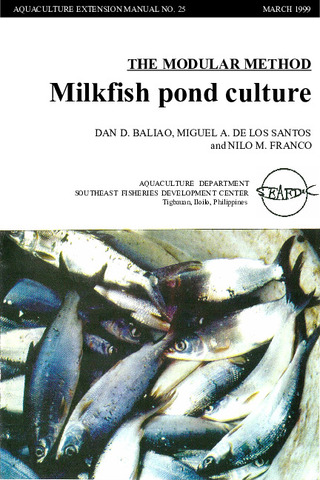Studies on the digestive lipases of milkfish, Chanos chanos
- Global styles
- MLA
- Vancouver
- Elsevier - Harvard
- APA
- Help

View/
Date
1990Author
Page views
3,457ASFA keyword
AGROVOC keyword
Taxonomic term
Metadata
Show full item record
Share
Abstract
Milkfish grown on two natural foods were examined to determine the distribution pattern of the digestive lipases along the digestive tract and to identify the optimum condition for lipase activity. One food consisted of a biological complex of unicellular algae and diatoms (Food A) and the other consisted of fibrous filamentous green algae, predominantly Chaetomorpha brachygona (Food B). The major sites of lipase secretion in milkfish digestive tract were the intestines, pancreas and pyloric caeca. Lipase activity was somewhat higher for fish grown on Food A than those grown on Food B. Intestinal lipase activity was observed to be maximal at 45°C and at pH 6.8 and 8.0. Activity of pancreatic lipase was observed to be maximal at 50°C and at pH 6.4 and 8.6. The detection of two well-defined pH optima, one at slightly acidic and the other at alkaline pH for both the intestinal and pancreatic lipases suggests a physiological versatility for lipid digestion in milkfish.
Suggested Citation
Borlongan, I. G. (1990). Studies on the digestive lipases of milkfish, Chanos chanos. Aquaculture , 89(3-4), 315-325. https://doi.org/10.1016/0044-8486(90)90135-A
Type
ArticleISSN
0044-8486Collections
- Journal Articles [1258]
Related items
Showing items related by title, author, creator and subject.
-
Series: Aquaculture extension manual; No. 25
The modular method: Milkfish pond culture
Baliao, Dan D.; de los Santos, Miguel A.; Franco, Nilo M. (Aquaculture Department, Southeast Asian Fisheries Development Center, 1999)The modular method of milkfish culture (Chanos chanos) described in the manual is an improvement over the traditional extensive method. The manual is intended for the use of fish farmers and aquaculturists, extensionists, ... -
Evaluation of organic and inorganic fertilizers in brackishwater milkfish ponds
Bombeo-Tuburan, Isidra; Agbayani, Renato F.; Subosa, Precilla F. (Elsevier, 1989)The study was conducted in twelve 144-m2 ponds to evaluate the effect of different organic and inorganic fertilizers on the growth, survival, gross production, and profitability of marketable milkfish. The ... -
Milkfish breeding and hatchery technology at SEAFDEC/AQD
Unknown author (Aquaculture Department, Southeast Asian Fisheries Development Center, 1999)Describes the techniques already adopted by the private sector: broodstock management, broodstock diet, commercial fry production, live transport, and larval diet. A list of AQD research publications on milkfish is included.





